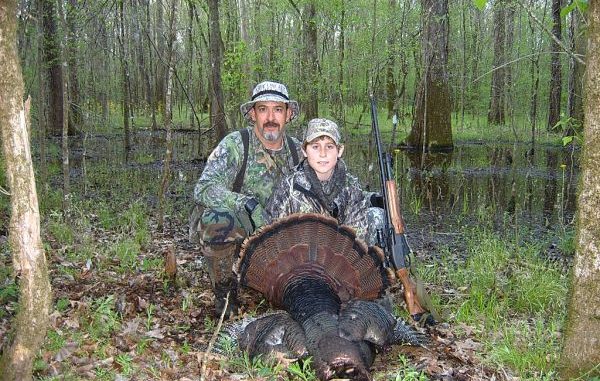
Fifty-three-year-old Matt Fruge’ lives on the west bank of the Atchafalaya River near the Sherburne Complex, and he’s hunted the complex ever since it was opened to turkey hunting in the 1990s.
He also is a volunteer guide for the youth turkey hunts on the area.
Over the years, Fruge’ has taken a dozen longbeards from these lands, with his largest bird taken in 2011. It weighed 21 pounds, and sported 1 ¾-inch spurs and a 10 ½-inch beard.
This accomplished public-land hunter said he’s learned a few scouting tricks over the years that lead to success once the season opens.
“The first thing I would advise is that hunters get out there and listen for gobbles,” Fruge’ said. “The birds will commonly be on the higher ridges of the swamps off Big and Little Alabama bayous, as well as the Bayou Des Ourses area.”
The hunter also said he stays with the birds as they come off the roost in order to pattern them to decide where he will set up once the hunting begins.
But once that is accomplished, the best bet is to leave it alone instead of messing around the area.
“And after you find that first gobbler, move away from him and listen in other areas,” he said.
Fruge’ actually locates three to four birds prior to the youth and lottery hunts.
“Last year, because of the flood of 2011, I heard a lot less gobbling activity due to fewer birds,” he said. “I had to look in different areas for sign — locations I would not normally hunt.”
Scott Pitre of Opelousas, a 47-year-old shipping manager of Targil Seasonings of Opelousas, is another Sherburne Complex turkey sleuth who said developing options during preseason scouting is a must.
“I would tell hunters to try and locate as many birds as possible before the hunting begins,” Pitre said. “I will have at least three to four birds located before opening day.
“I will try to locate as many vocal gobblers as I can before the season opens.”
Pitre prefers to listen first to gobbling aroused by the area’s own population of owls, crows and hawks.
“I will just listen at first, spending some time to see if a gobbler sounds off on his own,” the hunter said. “However, I will use either a hawk scream or owl hoot to try to get birds to gobble if it’s a quiet morning.”
Fruge’ also has strong words about using calls during scouting.
“Leave the hen calls at home,” he said. “I’ll use a crow call as a locator to get them to gobble, but that’s it.”
Pitre emphasized that woodsmanship and knowing the lay of the land is essential at being successful.
“You have to know where that gobbler will be moving once it leaves the roost,” said Pitre. “That’s where I’ll be set up to hunt them.
“And I have learned over the seasons to pick the most vocal bird to set up on opening day in the hopes that he will continue to gobble once the season opens.”
Both hunters, Fruge’ and Pitre will then set up in areas of movement of gobblers between the roost and feeding areas during opening day and thereafter.
Pitre uses technology to keep up with his findings.
“Today’s handheld GPS devices make it easier than ever before to scout for birds and position them — especially in the Atchafalaya Basin,” he said.
